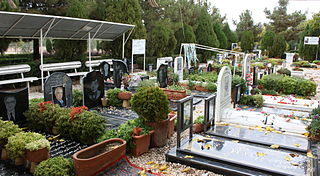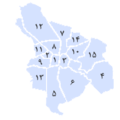
Naghsh-e-Jahan Stadium, is a football stadium in Isfahan, Iran. It has been the home stadium of Sepahan between its completion in 2003 and 2007, and again since its reopening in 2016. With a current seating capacity of 75,000 it is the second largest stadium in Iran.

Gavkhouni also written as Gawkhuni or Batlaq-e-Gavkhuni, located in the Iranian Plateau in central Iran, east of the city of Isfahan, is the terminal basin of the Zayandeh River. Gavkhouni is a salt marsh with a salinity of 31.5% and an average depth of about 1 m. The salt marsh can dry up in summer. The Zayandeh River originates in the Zagros mountains, and travels around 300 km, before terminating in Gavkhouni.

Isfahan Eastern Bypass Freeway is a freeway in Greater Isfahan Region, Isfahan, central Iran, bypassing the city of Isfahan on its eastern side. Section 1 and 2 of this Freeway was Completed in 2020 and The section 3 of freeway is currently under construction.

The Islamic City Council of Tabriz is the elected council that presides over the city of Tabriz, elects the Mayor of Tabriz, and budgets of the Municipality of Tabriz. The council is composed of twenty-one members elected from single-member districts for four-year terms. The Chairman and the Deputy Chairman of the Council are chosen by the council at the first regular meeting in odd-numbered years. In the last election between Principlists and reformers, Principlists won the most seats.

The following is a timeline of the history of the city of Isfahan, Iran.

The Islamic City Council of Isfahan is the directly elected council that presides over the city of Isfahan and elects the Mayor of Isfahan in a mayor–council government system.
Imam Khomeini Streetبزرگراه دو طبقه امام خمینی (ره) اصفهان is one of the most famous streets in the 12th district of Isfahan Province, Iran. In fact, the concrete flyover bridge that was built over it and its importance, made this street eminent and hard to ignore. It is also the way between Kharrazi Expressway and Isfahan-Tehran freeway.
Imam Khomeini Street is one of the most famous streets in the 12th district of Isfahan Province, Iran. In fact, the concrete bridge that built over it and its importance, made this street eminent and hard to ignore. It starts from Jomhouri-e-Eslami Square, and is the way between Kharrazi Expressway and Isfahan-Tehran freeway.
The article contains information about the 2019–20 Iran 3rd Division football season. This is the 4th rated football league in Iran after the Persian Gulf Cup, Azadegan League, and 2nd Division. The league started from 3 September 2019.
The 2019–20 Hazfi Cup was the 33rd season of the Iranian football knockout competition. The competition began in August 2019 and the final was played on September 3, 2020, which Tractor won for their 2nd title.

The government of Isfahan consists of a mayor and a 13 member municipal legislature. The Isfahan National Holy Association was involved in the Persian Constitutional Revolution. The politic of Isfahan is based on the 1979 Constitution, which made the country a theocratic Islamic republic in which the various powers are overseen by a body of clerics.

National Organization for Civil Registration of Iran is one of the governmental organizations in Iran that is responsible for collecting information and population statistics of Iran. This organization with independent duties and functions is one of the subordinate institutions of the Ministry of Interior of Iran. The organization is responsible for providing basic registration information such as births, deaths and marriages, as well as issuing identity documents such as birth certificates and Identity certificate. The current head of the organization is Hashem Kargar. In Iran, the third day of Dey (month) has been named as National Organization for Civil Registration Day.

Bagh-e Rezvan Cemetery is the biggest cemetery in Isfahan, Iran. There is a 55000m² water reservoir in the graveyard built in 2024, the biggest in the city.
The Book and Documentary Heritage Museum of Iran, an artistic historical museum based on the display of paper works, is one of the sections of the National Library and Archives of Iran. In this museum, a selection of historical works including books and non-books materials, documents, manuscripts, calligraphic tableaux and painting, periodicals, rare and exquisite printed books and works related to celebrities are exhibited.
District 13 is one of the largest of Isfahan's fifteen districts.
Risbaf was a textile spinning factory built in 1932 in Iranian city of Isfahan by German architects Max Oto Shonman and Iranian master builders called "Ostadmemars".

Neshan is an Iranian maps and navigation mobile application. It is a product of Fanap holding backed Razhman Data Structures. It also supports voice commands. It also shows the most fastest possibly route in Iranian cities. It has more than 10 million users. During 2019-2020 pandemic it showed crowded locations.

Isfahan Wildlife Park پارک آمورشی حیات وحش also called Soffeh Zoo پارک وحش صفه is a 5000 meters zoo located in Mount Soffeh park, District 5, Isfahan, Iran run by Isfahan Municipality. Around 318 rescue animals and 3 cloned animals from 36 species were held in the facility as of 1399 mostly in 2 meter cell spaces. This zoo has been highly criticized for its animal cruelty conditions. It was closed an repurposed to animal nursing for a full year since Covid in 2020. It was proposed to be closed down and another safari park be developed in East Park of Isfahan so as to earn revenue for the city's tourism It is supervised through department of environment. The zoo doesn't have green space. City council had tried to close it down in 2020.In August 2024 animals in there were passing out due to heat because of poor air ventilation.














